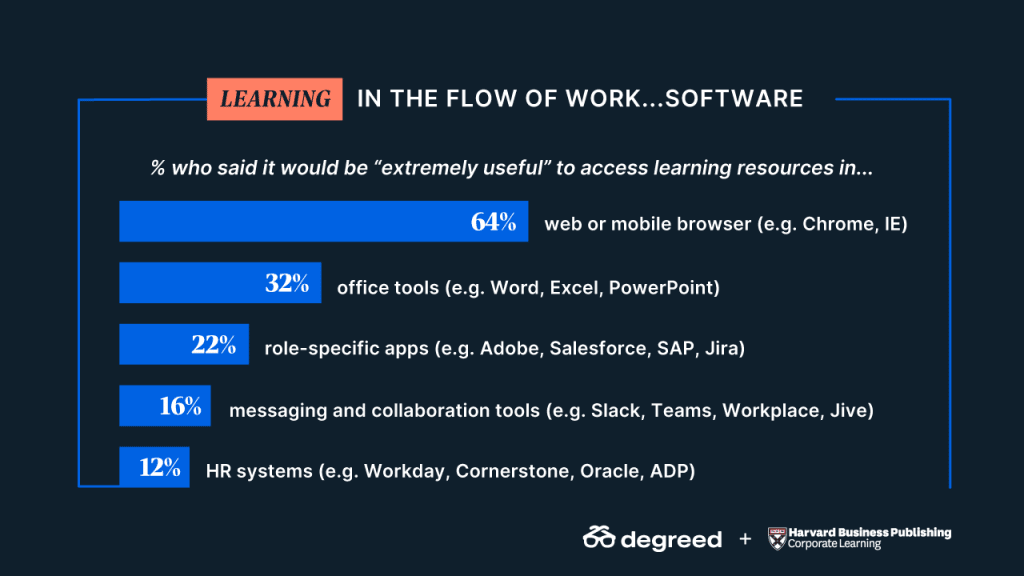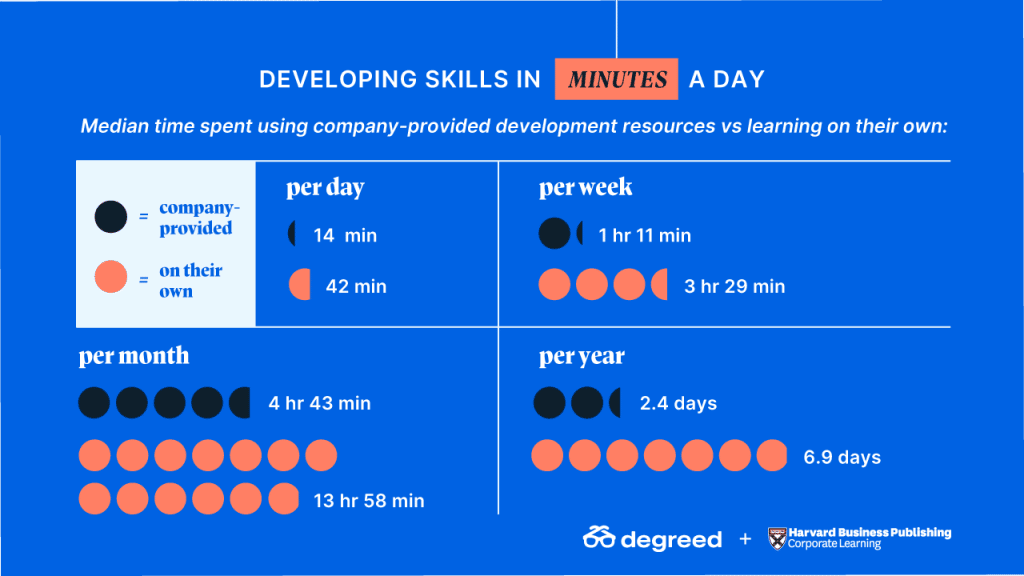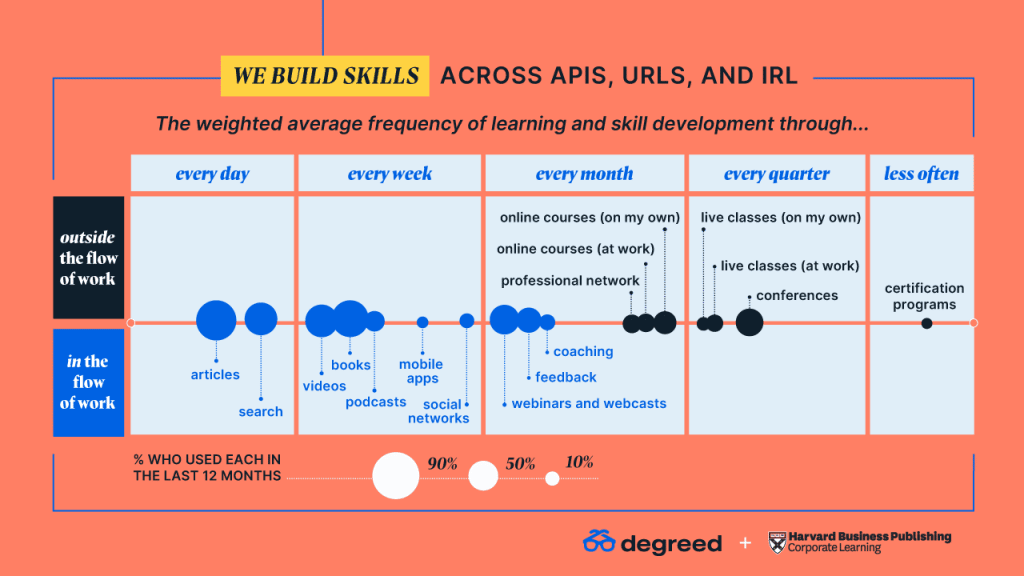Don’t believe the hype. Integrating learning in the flow of work is not as simple as just plugging your learning content into the systems and tools your people use to do their jobs — applications like Microsoft Teams and Office 365, Slack, and Salesforce — or even Google.
Sure, it’s a start. But to really weave learning in the flow of work, you need to think bigger and harder. Because now, people are also taking courses on Instagram, binge-watching how-to videos on TikTok, and connecting with coaches through Airbnb.
They’re even learning new skills on the job, in the real world, on their own.
All in, the workforce spends at least three times more time developing skills outside your HR and work systems than they do through your systems. And you can’t make intelligent decisions about where or how to invest in your people if you only see part of the picture.
Start Somewhere
We get it. You’re struggling to get people into your virtual classrooms and online courses, while Microsoft Teams has 115 million active users every day and Slack has 12 million. You fish where the fish are. So go ahead: embed learning in your workplace tools. It’s a smart place to start.
In fact, research by Degreed and Harvard Business Publishing’s Corporate Learning unit shows nearly one in five (16%) workers, managers, and business leaders say it would be extremely useful to access learning resources in their messaging or collaboration systems.

Even more of these people think it would be extremely useful to access learning through their office productivity apps (32%) or specialized job tools (22%), like Salesforce for sales reps or Jira and ServiceNow for IT professionals.
Across the board, people who have the most positive learning experiences at work are more likely to say these kinds of integrations into their workflow tools are helpful. There is potential here for sure. But there are also limits.
Be Useful
One big limit, of course, is time. The typical worker, manager, and business leader only spend an average of 14 minutes per work each day using company-provided resources to develop knowledge and skills for their career.

Next to that, the 90 minutes users spend active on Slack every workday are a tempting target. But if you want some of those minutes, get ready to fight for them, because people use Slack (and its competitors) mainly for communication and collaboration, not for learning in the flow of work.
Product designers call this idea jobs-to-be-done — the idea that people use specific tools to accomplish specific things. For Slack, the main jobs-to-be-done are messaging and sharing files. A typical user sends 200 messages a week.
Do the math on that. Two hundred messages a week works out to 40 a day, Monday to Friday; 29 if you include weekends. So if Slack users are only “active” for 90 minutes a day, that means they’re sending a message every two to three minutes.
And since COVID-19 forced the big shift to remote work, it’s gotten even harder. In the year from March 2020 to February 2021, time spent in Microsoft Teams meetings swelled by 2.5x and the average Teams user now sends 45% more chats per week.
In environments like those, there simply may not be as much room for meaningful learning as you’d think. Nearly three out of every four people (72%) in our study already said they can’t learn for more than 30 minutes at a stretch before getting distracted or interrupted.
The same goes for Salesforce, by the way. Sales reps spend 42% of their days working on tasks in CRM systems. But most of those tasks, like prioritizing leads, logging customer and deal information, or finding contacts, are all about productivity — not learning.
The fact is, people use work apps mainly to get work done. And whether they’re in Microsoft Office or on phones, TVs, printed pages, web pages, mobile apps, or chatbots, we have little patience for interruptions. So wherever you decide to put learning, make sure it’s useful.
Go Everywhere
No matter how useful the learning inside your company’s systems is, though, it’s still limited to your company’s systems. Your workforce is not. They’re not limited to your workplace, to your workweek, to your working hours, or to your technology.
What people forget in all the hype about learning in the flow of work is that a lot of work (as well as learning) still happens in real life — on the job, through independent experiences, and in interactions with other people, like colleagues, managers, mentors or customers.
The workers and leaders in our study invest three times more time developing skills on their own as they do through company-provided resources (a median of three and a half hours a week). And most of that time is not spent using traditional L&D solutions.
Only half took any live class (43%) or online course (52%), and two-thirds of them only did so three or four times. Most, however, leveraged articles (86%), books (79%), videos (63%), search (63%), webinars (59%), or podcasts (47%), usually at least once a week.

More than one in three people (36%) received coaching from a manager or mentor at least once a month, and 52% grew through feedback from their team or peers. In other words, most of how people develop their skills and learn in the flow of work happens everywhere — across APIs, URLs and IRL (in real life).
Contribute and Contextualize
That brings us back to those Instagram courses, TikTok videos, and Airbnb coaches. They’re just the beginning. You can now take a Harvard course in your email app, ask Alexa (or Google Glass) for instructions, and get coached by an AI-powered ‘bot named Otto.
You can also learn to create learning videos by watching YouTube videos or take tutorials on something called scrollytelling (an emerging skill in data visualization) on the blog of a company called Webflow.
There are a few things you can’t do, though. You can’t anticipate or manage everything people learn. You can’t cram it all into Teams or Salesforce. And you can not track completions on Instagram, TikTok, Airbnb, Gmail, Alexa, YouTube, blogs or in real life. Not really.
So what can you do with all that learning beyond the flow of work?
You can encourage people to explore it. You can guide them to relevant resources. And you can empower them to crowdsource and share useful learning wherever they find it. Help them contribute and add context to content, not just consume it.
Maybe that’s why two-thirds of the people we asked (64%) told us it would be “‘extremely useful” to access learning resources through their browsers. The browser, after all, is the one tool that goes pretty much everywhere people work (and read, watch, listen and communicate).
Oh, and don’t forget about Teams and Slack. A lot of that guiding, sharing, discussing, reflecting, and feedback happening on the job and in between people is happening in there — while they’re working. You can enable learning in the flow of work, you just can’t manage it.
Want to Learn More?
We recently released new and updated research in our latest version of How the Workforce Learns. Download the latest report today.

